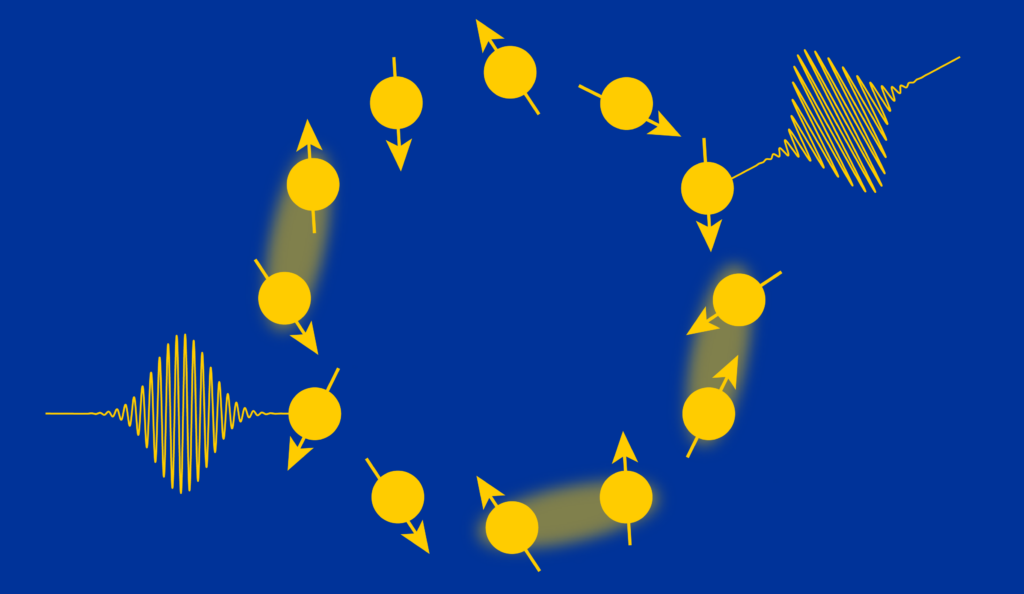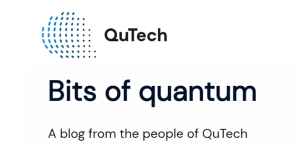This blog article was published on the QuTech blog “Bits of Quantum” on November 3, 2022.
Thrilled about how well the analogy works, we asked Valentin to publish his article on our blog. He kindly agreed 🙂 Enjoy!
Are you a Europhile or have you ever struggled to explain quantum computing to one? If so, then this guide has got you covered. We take the classical nation state and the European Union (EU) as an analogy to understand the concepts of ‘conventional’ classical computing and quantum computing. The EU can be confusing and overwhelmingly complicated, just like quantum computing. Perfect to better understand the quantum computer.
It is the year 1950. It is the aftermath of a complete failure of the nation state in Europe. While there is hope that the classical nation state will improve upon its designated task, Robert Schuman, French foreign minister, believes that there is more than the classical national computer. It is the idea about entangling nation states and creating a new way of governing. A united Europe driven by newly established institutions based in Brussels. This is our euro processor, the heart of this united Europe. Together with the classical nation states and the interconnection between them and the euro processor, this constitutes the euro computer.
By giving competences to a higher European institution, a classical nation state as we have known it until now could transform into a European Union member state. In Brussels these member states are called EUbits. Only if the heat in national debates is sufficiently low, integration becomes possible. In Rome in 1957, Schuman and co-workers were finally able to present the first 6-EUbits euro processor. These first demonstrations were no universal euro computers that can solve any arbitrary task, but were designed for very specific problems, e.g. establishing common coal and steel management and supervision. Together with Kohl and Mitterand, Jacques Delors could demonstrate the first euro processor with 13 EUbits in Maastricht in 1993. To date, the euro processor has grown to a 27 EUbits, and solves problems that none of its founding fathers would have ever dreamed about. It can solve universal tasks ranging from economic recovery policies to science and digital policy-making, as well as active peacekeeping measures.
Nonetheless, the euro processor is not a replacement for the classical national processor usually based in the capital of classical nation states. It serves as an addition that can solve a particular class of problems at a superior level, or even problems that the classical national processors cannot solve at all. This is evident when it comes to tackling tax evasion, digital data privacy and frictionless trade. The quantum computer is the European Union of computers. Understanding the euro processor gives insight into the foundations of quantum computing. So let’s have a look at the euro processor together first and then at the analogies with quantum computing.
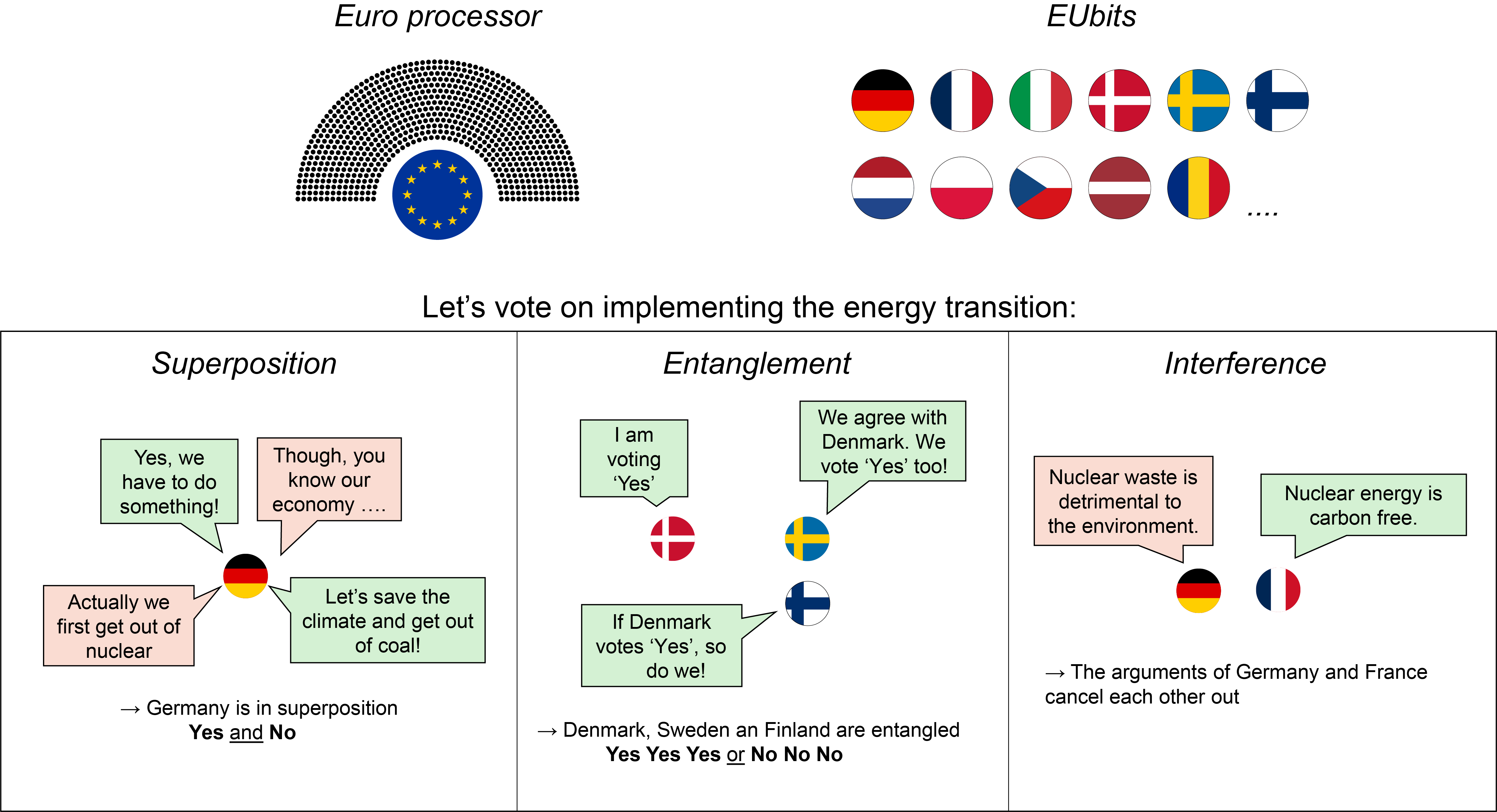
Working principle of the euro processor – Superposition, entanglement and interference
Suppose there is a policy proposal for the European Union to discuss. The question is whether Europe should take a stronger stance against climate change. Before the vote, countries take different stances. [tooltips keyword=”Sweden” content=”All country choices only serve demonstrative purposes without judgement, and should be seen with a wink. Of course these countries and their political dynamics are significantly more complex and diverse than what is implied here.”] is clearly in favour of accepting the policy proposal. We say that Sweden is in state 1. On the contrary, [tooltips keyword=”Poland” content=”All country choices only serve demonstrative purposes without judgement, and should be seen with a wink. Of course these countries and their political dynamics are significantly more complex and diverse than what is implied here.”] is clearly against the proposal. We say that Poland is in state 0. [tooltips keyword=”Germany” content=”All country choices only serve demonstrative purposes without judgement, and should be seen with a wink. Of course these countries and their political dynamics are significantly more complex and diverse than what is implied here.”] is somehow in favour and against the proposal at the same time. They do not want to risk any economic consequences, but are under pressure from NGOs and media. We say that Germany is in a superposition of state 1 and 0.
Only European Union member states that we have introduced as EUbits can hide behind a joint European position and remain ambiguous on certain topics. For other countries, we observe another interesting behaviour. Denmark, Sweden and [tooltips keyword=”Finland” content=”All country choices only serve demonstrative purposes without judgement, and should be seen with a wink. Of course these countries and their political dynamics are significantly more complex and diverse than what is implied here.”] always seem to have the same opinion. We call this entanglement. Countries can be entangled with the same and opposite opinions. If one of the Scandinavian countries is in state 1, all of them are in state 1. If one Scandinavian country is in a superposition, all of them are in superposition. On the other hand, for [tooltips keyword=”the Netherlands” content=”All country choices only serve demonstrative purposes without judgement, and should be seen with a wink. Of course these countries and their political dynamics are significantly more complex and diverse than what is implied here.”] and [tooltips keyword=”Spain” content=”All country choices only serve demonstrative purposes without judgement, and should be seen with a wink. Of course these countries and their political dynamics are significantly more complex and diverse than what is implied here.”] it is opposite. If the Netherlands is in state 1, Spain is always in the state 0.
When countries discuss the pros and cons of the proposal, two countries may have opposite concerns, such that their views interfere with each other. If they have equal weight, their arguments completely cancel out. On another occasion, countries may have similar concerns that even amplify each other, which leads to an increased weight of the argument. We call these phenomena interference.
These three phenomena, superposition, entanglement and interference, make our initial classical nations into EUbits. They are the foundation of the euro processor. EU member states have 2 weeks to discuss the proposal with one another. Meanwhile, they also have internal discussions, where the position on a certain topic can flip or be brought in and out of superposition. In Brussels these are called single EUbit gates. Single EUbit gates only change the position on the policy proposal within a single country. It can go to 1, 0 or in superposition. After that, we have two-EUbit gates. In two-EUbit gates, two neighbouring countries exchange opinions and change their position accordingly. In this fashion, many single and two EUbit gates are implemented. EU member states will be in superposition, will get entangled with each other and their arguments will interfere. We call the sequence of the gates euro algorithm.
Working principle of the euro processor – Measurement and euro advantage
Finally, it is time to vote on the policy proposal. Each EU member state must say either YES (1) or NO (0), even if they are in superposition, which means that they are continuously changing their minds. After the vote, they cannot change their minds anymore: no EU member state is in superposition anymore. We cannot tell from the result which EU member state was in which state. If we want to find out, we need to repeat the whole process many times and let each country vote in the end. For example, if Sweden voted ‘yes’ 10 times, it was in state 1. If Germany voted ‘yes’ and ‘no’ 5 times each time, it was in superposition. If Poland voted ‘no’ 10 times, it was in state 0. In this way, we can determine the position of all EU member state. In the example here, 10 repetitions were necessary to be certain that a country was in superposition. Therefore, we need to repeat the measurement at least 10 times. Now we know the position of all our countries on climate change.
If a euro computer does not exist, there is only one way to find out the different positions of the European countries on climate change. We have to go to each European country separately and analyse their policy proposals. This means executing the same algorithm 27 times instead of only 10 times. Therefore, the euro computer can solve this problem faster than the classical national computer. We have obtained euro advantage.
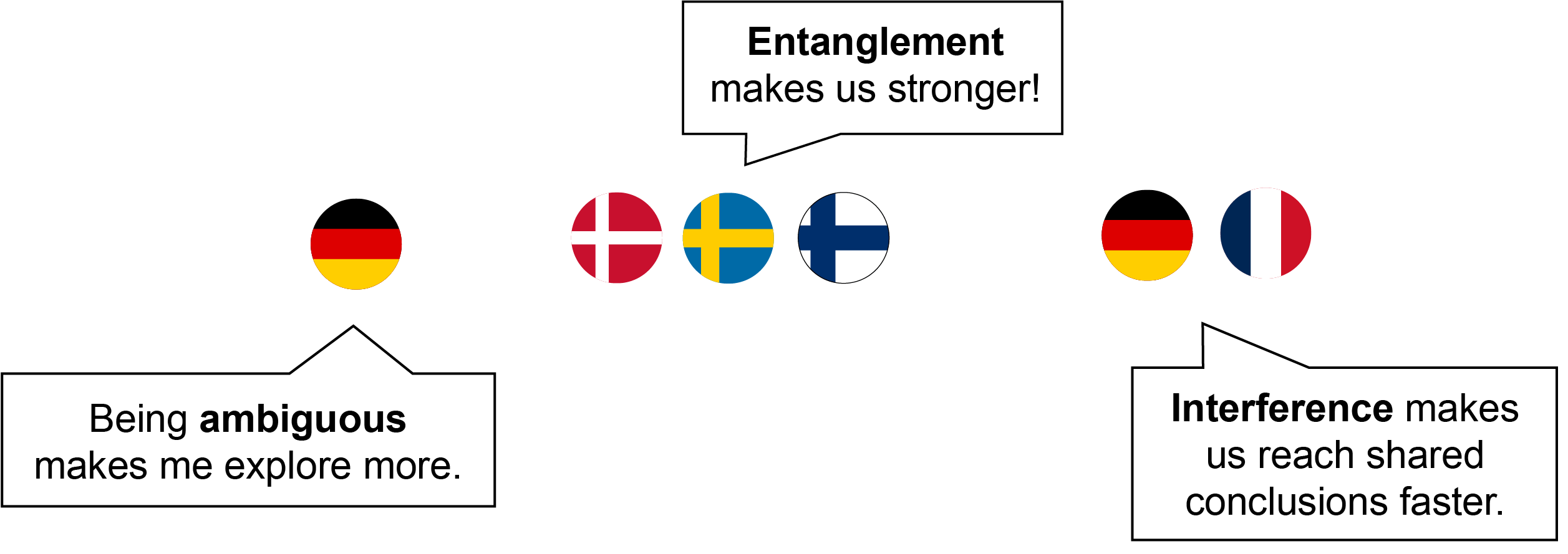
From euro computing to quantum computing
The phenomena that govern the operations in the European Union can be viewed in a similar fashion as the phenomena that distinguish classical computers from quantum computers. The concepts of superposition, entanglement and interference are unique to quantum mechanics, and can be exploited to speed up certain types of algorithms. This particularly concerns algorithms where tasks can be executed in parallel, similar to the determination of the climate change positions in the example. It is easy to imagine that the larger the number of countries, the larger the speed-up for the climate problem stated here. This makes it possible to simulate problems that are out of reach for classical computers.
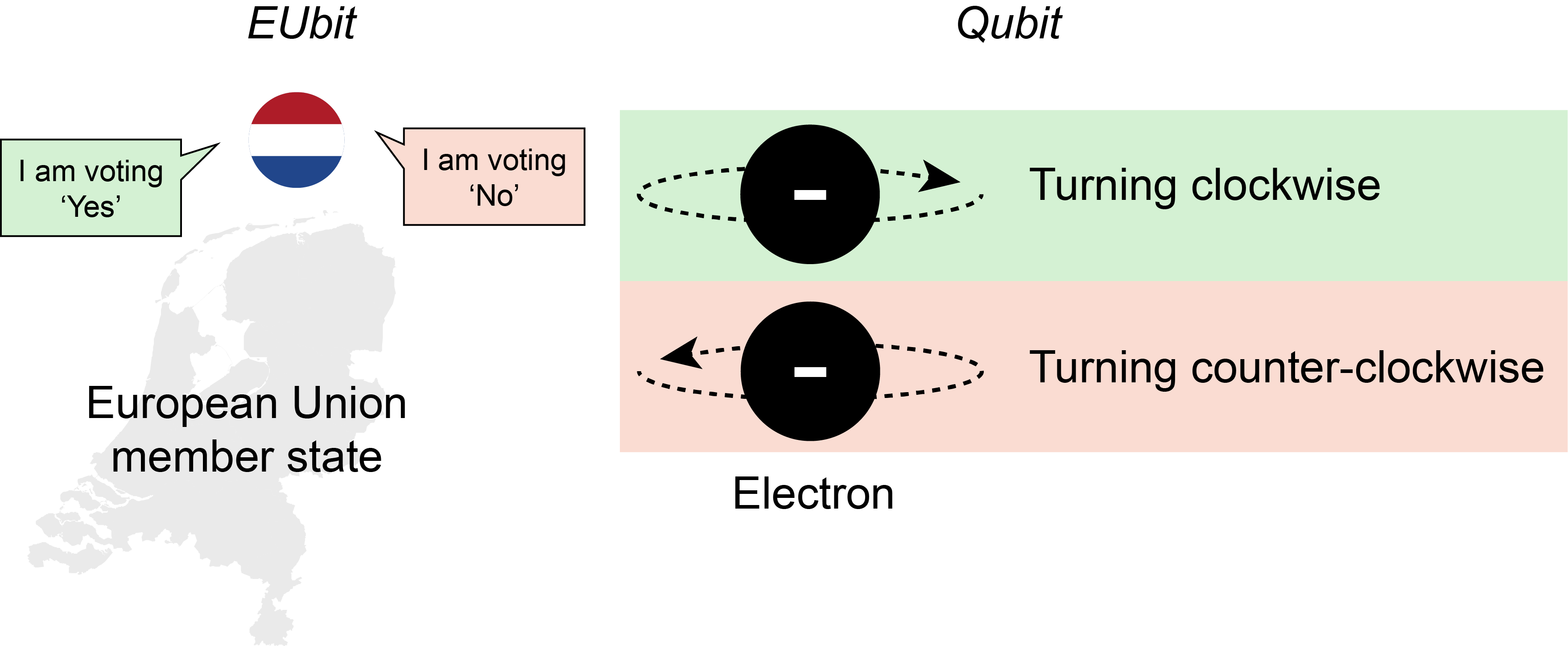
Information in classical computers is physically encoded in zeros and ones. This is done in silicon chips that host billions of tiny electrical switches. Either current flows, then we have 1, or no current flows, then we have 0. This is called a bit. Quantum computers work differently. Instead of working with bits, they work with quantum bits or qubits for short. A qubit is a bit that requires the three additional concepts of superposition, entanglement and interference that we have introduced for our euro processor. Qubits can be defined, for example, by trapping a single electron, the particle that makes up current. An electron can be envisaged as a ball that can spin either clockwise or counter-clockwise. This corresponds to 0 and 1 respectively. Since an electron is a quantum mechanical particle, it is governed by the effects of superposition, entanglement and interference. In the euro processor, superposition was defined by strategic ambiguity; now it is defined by quantum mechanics.
When the electron is spinning clockwise and counter-clockwise at the same time, it is in superposition. This may seem odd, and is why quantum mechanics is often considered unintuitive. Here, there is no need to deeply understand why a quantum object behaves as such. Instead, we simply exploit these phenomena. On qubits, we apply single and two-qubit gates that make up a quantum algorithm, just like described for the climate policy analysis of the euro processor. Importantly, the quantum computer must be seen as an addition to a classical computer, just as the European Union should be seen as an addition to the nation state. Quantum computing and the European Union can only exist if certain criteria are met, but add value that improves the lives of European Union citizens.
| Euro processor | Quantum processor | |
| Basic unit of information (Bit) |
EUbit: European Union member states |
Qubit: Electron (many other similar qubit implementations are also explored) |
| Logical states representing 0 and 1 | Voting ‘Yes’ or ‘No’ | Spinning ‘clockwise’ or ‘counter-clockwise’ |
| Superposition | Countries can stay ambiguous towards certain topics | Electrons can spin clockwise and counter-clockwise at the same time thanks to quantum mechanics |
| Operational temperature | Room temperature | Close to absolute zero |
| Application | Dealing with issues that the independent nation states are incapable of doing alone, e.g. tax evasion, climate change etc. | Calculating a certain class of problem that are out-of-reach for classical computers, e.g. simulating properties of molecules |
Application and maturity of quantum computing
The euro processor has two obvious areas of application. First, the execution and analysis of European policy-making. After all this is the very foundation of the euro processor, so it makes sense that it can simulate these systems significantly better than classical computers. The same applies to quantum computers. They are based on quantum mechanics and can therefore potentially solve quantum mechanical problems that are unsolvable today by classical computers. Our macroscopic world that we experience ourselves can be well described with classical physics, and thus by classical computers. This is because we can ignore microscopic phenomena. This no longer holds true when we look at phenomena occurring at the atomic scale. There, quantum mechanics governs the properties of particles and atoms. Quantum mechanical descriptions are always complex and difficult if not impossible to calculate with classical computers. Simulating the behaviour of a specific molecule is a typical example of such a quantum mechanical problem. It is important to know that even relatively small and simple problems in quantum mechanics are impossible to simulate nowadays.
Now you may wonder, why should I care? The reason is that these computations may lead to a new era in technological and scientific progress. Research groups and companies could potentially simulate novel molecules, materials, and eventually proteins, leading to major advances in industries such as aviation, chemistry, and life sciences. It allows better optimisation of design choices, understanding and improving chemical processes, simulating new molecules and materials to find the best ones for current and future applications. Obviously, this list is by no means exhaustive, and we may not even be aware of certain future applications.
However, we are not there yet. The state of quantum computing today is comparable to the state of classical computers in the 1960s. This was the period when the rise of today’s semiconductor giants such as Intel began. Currently, the technology is moving from university research to industry. Established high-tech players like Google and IBM are currently leading this transition. In the European Union, in addition to various research efforts, there are notable start-ups building quantum chips based on different technologies. These include QuantWare, IQM, AQT, Pasqal and Quandela. Despite recent successes like Google’s quantum advantage claim, the current benefit of the technology is limited. There are also voices raising concerns about the level of maturity and the excessive claims made by the quantum community. With all the claims, it is important to remember that quantum computing is in the development phase, and no one knows exactly what it will eventually be able to do. Still, the ongoing development and current dynamics are very exciting, and you can be sure that you will hear more in the coming years.

About Valentin
If Valentin John had not become a physicist, he may have very well become a Eurocrat himself. He is European from the bottom of his heart, having spent part of his studies in Germany (his home country), the UK, Belgium and France. In the past, triggered by the Brexit vote, he has also been active with the Young European Federalists. Now, the passion for semiconductor devices and quantum technology has brought him to Delft, where he researches on realizing quantum processors based on gate-defined quantum dots in the Veldhorst lab. In his spare time he likes to bake his beloved German bread, cook vegan food and play football.
